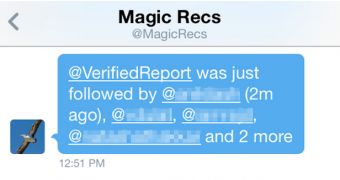Security experts from Symantec have come across a new type of Twitter scam. The scammers are creating bogus Twitter experiment accounts in an effort to get unsuspecting users to follow them.
The cybercrooks are most likely inspired by legitimate services such as Event Parrot and Magic Recs, which send users breaking news and personalized recommendations.
Experts have come across a couple of fake accounts, @VerifiedReport and @MagicReports, that claim to be “changing the way users interact with journalists and news organizations.”
Unfortunately, a large number of users, including Twitter employees, followed the bogus “experiment” accounts before they were suspended by the social media network. Interestingly, even the genuine @MagicRecs recommended them.
On the other hand, there still are some accounts that haven’t been suspended by Twitter. The list includes @MagicFavs, @MagicSmacks and @MagicSext. This last account was recommended by @MagicRecs and it already has over 1,200 followers.
It’s uncertain why scammers have created the accounts since, so far, they haven’t been used to send out direct messages containing links.
“While it’s still unclear what these accounts were created to do, it serves as a reminder that scammers continue to experiment with new ways to scam unsuspecting Twitter users into clicking on links to steal login credentials or make money through affiliate program schemes,” Symantec’s Satnam Narang noted in a blog post.
In this case, the bogus accounts have been harmless so far. However, they could start distributing links to shady websites at any moment, which is why users are advised to act with caution.
If you come across so-called Twitter experiment accounts, make sure they’re legitimate before following them. If the account is not verified, you’re likely dealing with a scam.
However, ensure that the verified logo is real. When you hover over it with the mouse, it should read “Verified account.” If it doesn’t, the scammers have probably used a header image that contains the logo.

 14 DAY TRIAL //
14 DAY TRIAL //